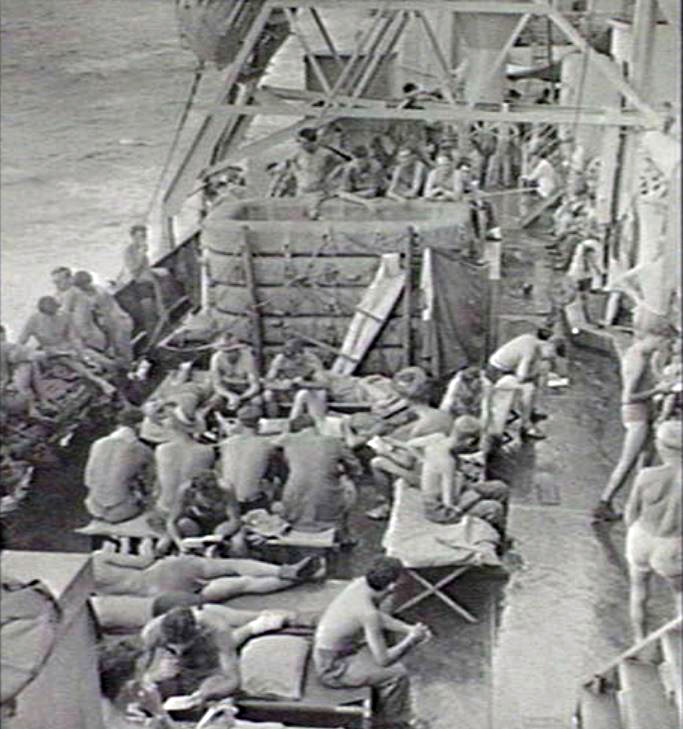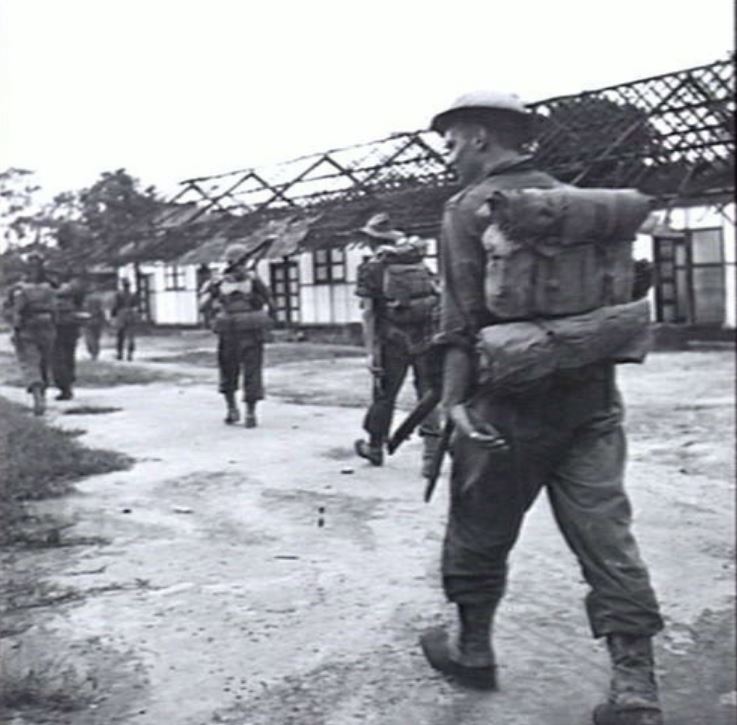2/27th Australian Infantry Battalion
From Our Contribution
 7 Feb 1946 off Macassar. 2/27 aboard USAT Winchester Victory returning to Australia AWM photo 125862 | |
 A Coy patrol entering Sambodja near Balikpapan AWM photo 111756 |
Contents
Brief History
The 2/27 Battalion was raised at Woodside in South Australia during May 1940. On 19 October the battalion left Woodside, by train, for Melbourne where it sailed for overseas on 21 Oct 1940. After a brief stop in India they disembarked in Egypt on 24 Nov 1940 and moved to Palestine to complete its training. As part of the 21st Brigade of the 7th Australian Division, the 2/27th's first operational role was to bolster the defences along the Egypt-Libya frontier against an expected German attack. It occupied positions at Maaten Bagush and Matruh throughout much of April and May 1941, before returning to Palestine in preparation for its first offensive operation - the invasion of Syria and Lebanon, which began on 8 June.
The 2/27th was involved in the drive north along the Lebanese coast with outflanking moves in the hills that edged the coastal plain. Its major actions were at Adloun on 11 June, Miyeoumiye on 13-14 June and around El Boum, as part of the battle of Damour, between 6 and 9 July. After the armistice of 12 July, the 2/27th remained in Lebanon as part of the Allied garrison until 11 Jan 1942.
After sailing from Egypt on 30 Jan 1942, the 2/27th disembarked in Adelaide on 24 March. Its stay in Australia was brief. On 14 August it disembarked at Port Moresby in Papua, and by 6 Sep 1942 it was at Mission Ridge on the Kokoda Trail preparing to meet the Japanese advance. The battalion held on to its positions for two days before being forced to pull out by a Japanese outflanking move that cut the Trail behind it. A grim two week withdrawal through the jungle, with little food, followed. Sick and exhausted, the 2/27th re-joined the main Australian force at Jawarere, 40 kilometers east of Port Moresby, on 22 Sep 1942. After a period of rest and retraining the 2/27th returned to action at Gona on 28 Nov 1942. It suffered heavily in a series of rushed and ill-conceived attacks and was further assailed by the ravages of tropical disease. By the time it was relived on 6 Jan 1943, it was only 70 strong.
The 2/27th returned to Australian in mid-January but was back in Papua by early August. It spent a month training near Port Moresby before being flown to Kaipit in New Guinea to take part in the advance along the Ramu Valley. Leaving Kaipit on 29 September, the 21st Brigade reached Dumpu on 4 October and then began pushing up into the Finisterre Ranges. The 2/27th occupied several key features during these operations and bore the brunt of the one major counterattack launched by the Japanese on 12 October. Thereafter, the 2/27th's operations were principally patrol actions. It began returning to Port Moresby on 3 Jan 1944, and arrived back in Australia on 1 March.
The 2/27th left Australia for its last operation of the war on 3 Jun 1945. The battalion landed at Balikpapan on 1 July and after the attacks of that day, conducted with relatively light casualties, its operations were confined mainly to small-scale patrolling until the end of the war on 15 August. From mid-October to late January 1946 the 2/27th formed part of the occupation force in the Celebes. It sailed for home for the last time on 4 Feb 1946, arrived at Brisbane on 14 February, and was disbanded there on 18 March.
226 men died while posted to this unit and two were captured on Crete.
Battle Honours
- Adlun
- Balikpapan
- Borneo 1945
- Buna-Gona
- Damour
- Efogi-Menari
- Gona
- Kokoda Trail
- Ramu Valley
- Shaggy Ridge
- Sidon
- Syria 1941
- The Litani
Individual Honours
- 2 x Distinguished Service Orders
- 3 x Military Cross
- 1 x Bar to Military Cross
- 1 x Distinguished Conduct Medal
- 17 x Military medal
- 49 x Mentioned in Despatches
Unit Peresonnel
- Edward Maurice Trew 20 Nov 1945 - 12 Feb 1946
Notes
Detail comes from AWM website accessed 26 Aug 2022